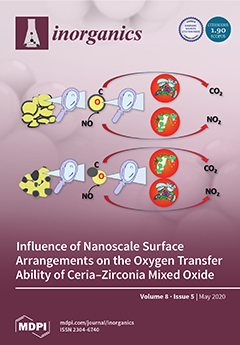The self-assembly reaction between NiI
2, benzoic acid (PhCO
2H) and the Schiff base chelate,
N-naphthalidene-2-amino-5-chlorobenzoic acid (nacbH
2), in the presence of the organic base triethylamine (NEt
3), has resulted in the isolation and the structural, spectroscopic,
[...] Read more.
The self-assembly reaction between NiI
2, benzoic acid (PhCO
2H) and the Schiff base chelate,
N-naphthalidene-2-amino-5-chlorobenzoic acid (nacbH
2), in the presence of the organic base triethylamine (NEt
3), has resulted in the isolation and the structural, spectroscopic, and physicochemical characterization of the dodecanuclear [Ni
12I
2(OH)
6(O
2CPh)
5(nacb)
5(H
2O)
4(MeCN)
4]I (
1) cluster compound in ~30% yield. Complex
1 has a cage-like conformation, comprising twelve distorted, octahedral Ni
II ions that are bridged by five μ
3-OH
−, one μ-OH
−, an I
− in 55% occupancy, five PhCO
2− groups (under the η
1:η
1:μ, η
1:η
2:μ
3 and η
2:η
2:μ
4 modes), and the naphthoxido and carboxylato O-atoms of five doubly deprotonated nacb
2− groups. The overall {Ni
12} cluster exhibits a nanosized structure with a diameter of ~2.5 nm and its metallic core can be conveniently described as a series of nine edge- or vertex-sharing {Ni
3} triangular subunits. Complex
1 is the highest nuclearity coordination compound bearing the nacbH
2 chelate, and a rare example of polynuclear Ni
II complex containing coordinating I
− ions. Direct current (DC) magnetic susceptibility studies revealed the presence of predominant antiferromagnetic exchange interactions between the Ni
II ions, while photophysical studies of
1 in the solid-state showed a cyan-to-green centered emission at 520 nm, upon maximum excitation at 380 nm. The reported results demonstrate the rich coordination chemistry of the deprotonated nacb
2− chelate in the presence of Ni
II metal ions, and the ability of this ligand to adopt a variety of different bridging modes, thus fostering the formation of high-nuclearity molecules with rare, nanosized dimensions and interesting physical (i.e., magnetic and optical) properties.
Full article





